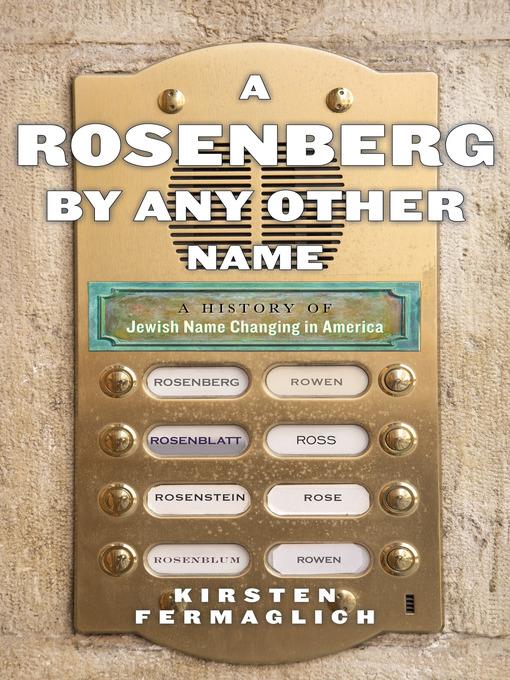
A Rosenberg by Any Other Name
A History of Jewish Name Changing in America
- اطلاعات
- نقد و بررسی
- دیدگاه کاربران
نقد و بررسی

August 27, 2018
Fermaglich (American Dreams and Nazi Nightmares), a professor of history and Jewish studies at Michigan State University, supplies much fascinating anecdotal material and socioeconomic analysis in this history of Jewish name-changing in New York City in the mid-20th century. Formal petitions by Jews to anglicize or otherwise change their names—a somewhat cumbersome and expensive process—increased in the 1940s from 250–300 per year to 800. Fermaglich shows how, particularly in the 1940s and ’50s, name changing was undertaken overwhelmingly by native-born Jews who lived in largely upper-middle-class neighborhoods, not out of self-hatred but because, in a time of considerable anti-Semitism, they sought a measure of “personal invisibility” to afford themselves more educational and professional opportunities. She discusses how the end of mass anti-Semitism (in the second half of the century) and the growth of ethnic pride among Jews (and others) led not only to a significant decline in Jewish name changing but also to the practice being viewed with disfavor by many younger Jews. She pads her work a little at the end by cursorily discussing name-changing among other ethnic groups, including Arabs and Muslims in the post-9/11 era. Still, this is a fine contribution to an important, previously underexplored area of American Jewish identity and social history.

September 1, 2018
An exploration of how, during times of social stress and rampant anti-Semitism, large numbers of Jews in America formally applied to change their names to less ethnically identifiable ones. Fermaglich (History and Jewish Studies/Michigan State Univ.; American Dreams and Nazi Nightmares: Early Holocaust Consciousness and Liberal America, 1957-1965, 2006, etc.) looks at the applications for name changes in New York City from the 1920s to the present. She notes that the "institutionalized" anti-Semitism in the country following World War I prompted many to register for a name change; sometimes, entire families did so. The changers usually felt that their patently Jewish names were hurting them regarding employment, residence, college applications, and other areas. As the author notes, sometimes these changes created conflict in families--and among the general Jewish population, who occasionally found such changes to be evidence of self-loathing and of disrespect for cultural history. But as Fermaglich demonstrates, the trend has diminished: Non-Jewish Americans have become less openly biased against Jews, and colleges have removed application questions designed to identify Jews. In NYC today, Jews no longer dominate the requests for name changes. The author clearly spent hours poring through official records in the city (she provides some charts and other illustrations), and she offers summaries of similar research done elsewhere in the country and shows us how the name-changing practice appeared in the popular culture throughout the decades. Some familiar names pop up in her discussions--e.g., Arthur Miller, Henry Roth, Bernard Malamud, and Philip Roth. The text is academic in tone and presentation (40 pages of endnotes follow), and the virtual absence of subheadings and breaks of other sorts renders the volume not entirely reader-friendly. However, the rewards for resolute readers are considerable.Fermaglich's thorough research and bright insights produce a provocative account of a seldom-explored cultural phenomenon.
COPYRIGHT(2018) Kirkus Reviews, ALL RIGHTS RESERVED.

October 15, 2018
Fermaglich (history, Jewish studies, Michigan State Univ.; American Dreams and Nazi Nightmares) has written an important history of the evolution of Jewish name-changing in America, not specifically as an escape from Jewish identity but as a means toward greater access to success in social, cultural, and political life in 20th-century America. In tracing the balancing act between the desire to become more American while experiencing the loss of ethnic pride, this scholarly book shows that most name-changing came about as a result of anti-Semitism both before and after World War II. Using court documents and other public records, Fermaglich demonstrates that Jewish name-changing was an important sociological phenomenon from the 1910s to the 1960s. The well-written and thoroughly documented narrative effectively demonstrates the struggle that individuals underwent to become fully realized as Jewish Americans. VERDICT Highly recommended for general readers as well as academic collections of Jewish studies, ethnic studies, and immigration studies.--Herbert E. Shapiro, Lifelong Learning Soc., Florida Atlantic Univ., Boca Raton
Copyright 2018 Library Journal, LLC Used with permission.




دیدگاه کاربران